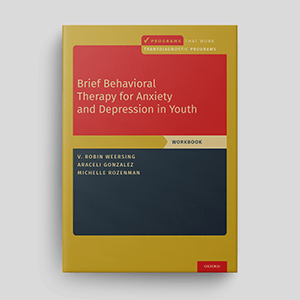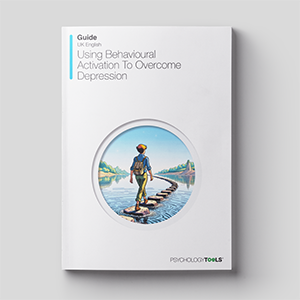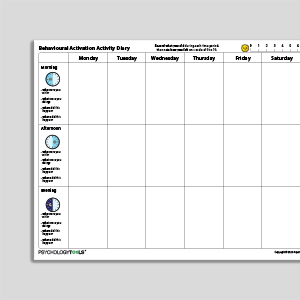Brief Behavioral Therapy for Anxiety and Depression in Youth: Therapist Guide
The Brief Behavioral Therapy for Anxiety and Depression in Youth program provides step-by-step instructions and evidence-based strategies for supporting young people experiencing depression and anxiety. A client workbook is downloadable separately.
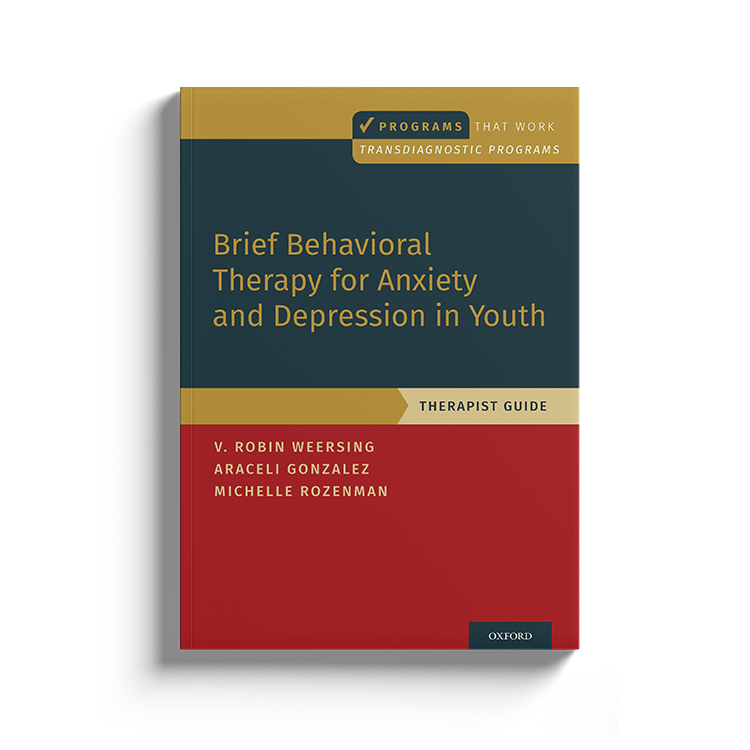
Download or send
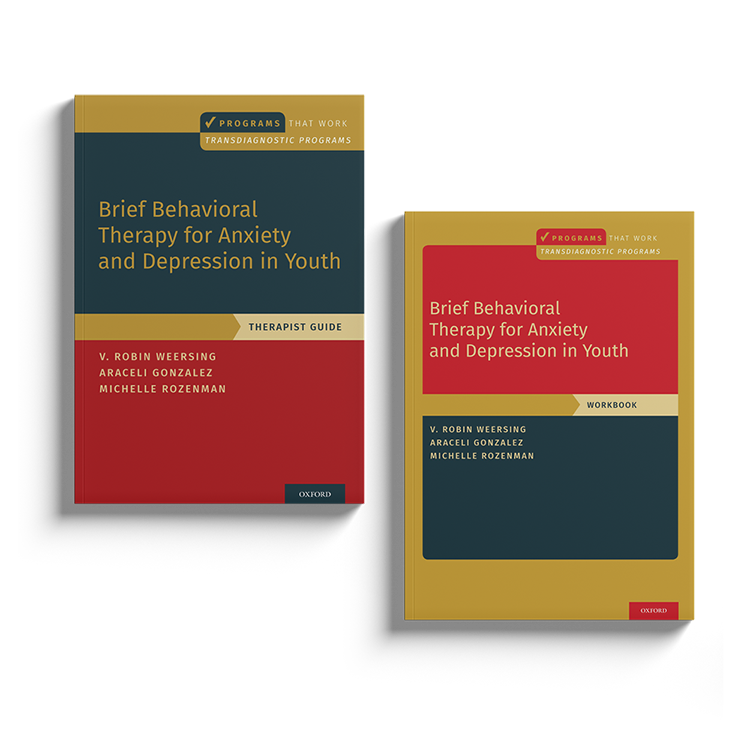
Overview
The Brief Behavioral Therapy for Anxiety and Depression in Youth guide is a concise, transdiagnostic intervention designed for common internalizing disorders — namely anxiety and depression — in children and adolescents. Focusing on shared mechanisms such as avoidance and negative affectivity, it simplifies treatment by using a unified framework. Brief Behavioral Therapy (BBT) integrates key behavioral strategies like graded engagement, which combines elements of exposure and behavioral activation, to encourage approach behaviors and restore meaningful activity. Additional tools include stress management and problem-solving techniques, enhancing its flexibility. The approach is especially useful in pediatric settings, where emotional distress may be expressed through physical symptoms. Research supports BBT’s effectiveness across diverse populations, including underserved and minority youth. As part of the Treatments That Work™ series, this guide offers practical, evidence-based guidance for clinicians seeking accessible and scalable treatment options for internalizing disorders in young people.
Why use this resource?
This program provides a step-by-step, structured approach for treating children and young people experiencing anxiety and depression. It includes:
- Detailed explanations of cognitive-behavioral principles tailored to anxiety and depression.
- Evidence-based interventions for overcoming anxiety and low mood.
- Practical guidance for structuring sessions and implementing client exercises.
- Strategies for overcoming common obstacles during treatment.
Key benefits
Structured
Educational
Effective
Trusted
What difficulties is this for?
Anxiety
Distressing worries, persistent fearfulness, and avoidance.
Depression
Persistent low mood, loss of interest, and withdrawal.
Mixed Symptoms
Overlapping anxiety and low mood requiring an integrated approach.
Integrating it into your practice
Assessment
Explore how children and young people (CYP) experience anxiety and/or low mood.
Psychoeducation
Teach clients about mood-related difficulties and what maintains them.
Skills
Implement effective cognitive-behavioral interventions to address key symptoms.
Monitoring
Use structured worksheets to track progress and refine interventions.
Relapse Prevention
Equip clients with long-term strategies for maintaining their progress.
Theoretical background and therapist guidance
Internalizing problems – encompassing feelings of sadness, worry, irritability, and fear – are among the most prevalent psychiatric concerns throughout people’s lives. In youth, nearly one in three children experiences clinically significant anxiety, and one in four undergoes a depressive episode before reaching puberty (Merikangas et al., 2010). Left untreated, these issues can lead to a range of long-term consequences, including chronic depression, poor physical health, academic difficulties, substance abuse, and increased mortality from suicide (Bittner et al., 2007; Fergusson & Woodward, 2002; Pine et al., 1998). Moreover, anxiety and depression often co-occur, with up to 70% of treatment-seeking youth presenting with both disorders, leading to worsened outcomes (Garber & Weersing, 2010).
Despite the high prevalence and significant impact of these issues, internalizing disorders in youth remain underserved in mental health systems and historically underrepresented in clinical research. The child and adolescent anxiety and mood program (ChAAMP) sought to address these gaps, focusing on community service delivery, shared mechanisms across disorders, and the development of innovative, transdiagnostic treatments. The culmination of this work is the brief behavioral therapy (BBT) model for pediatric anxiety and depression, on which this guide is based.
Unlike traditional disorder-specific CBT approaches, BBT offers a transdiagnostic framework that targets shared mechanisms underlying anxiety and depression, such as avoidance, withdrawal, and negative affectivity. Studies have shown that these approaches are effective in improving outcomes across both conditions, particularly when delivered in medical settings like pediatrics, where somatic complaints often signal underlying mental health concerns (Lynch et al., in press; Weersing et al., 2017). Moreover, the transdiagnostic approach is especially beneficial for racial and ethnic minority populations, who often face barriers to accessing effective mental health care (Weersing & Weisz, 2002).
Research consistently supports the efficacy of transdiagnostic CBT approaches for youth. For example, BBT’s behavioral focus aligns with evidence demonstrating that exposure and behavioral activation are highly effective for treating anxiety and depression (Anderson et al., 2016; Newby et al., 2016). Additionally, studies have highlighted that shared intervention strategies for internalizing disorders can simplify treatment delivery while maintaining strong outcomes, as shown by comparable improvements in anxiety and depressive symptoms (García-Escalera et al., 2016; Ehrenreich-May et al., 2017).
By emphasizing simplicity, scalability, and effectiveness, BBT equips clinicians with a powerful tool to address anxiety and depression in youth. This guide provides therapists with a clear roadmap for implementing BBT, offering hope and practical strategies for young people and families facing internalizing challenges.
Authored by leading psychologists including David Barlow, Michelle Craske and Edna Foa, Treatments That Work™ is a series of manuals and workbooks based on the principles of cognitive behavioral therapy (CBT). Each pair of books (Therapist/Clinician Guide and Workbook) contains step-by-step procedures for delivering evidence-based psychological interventions and will help you to provide the best possible care for your clients.
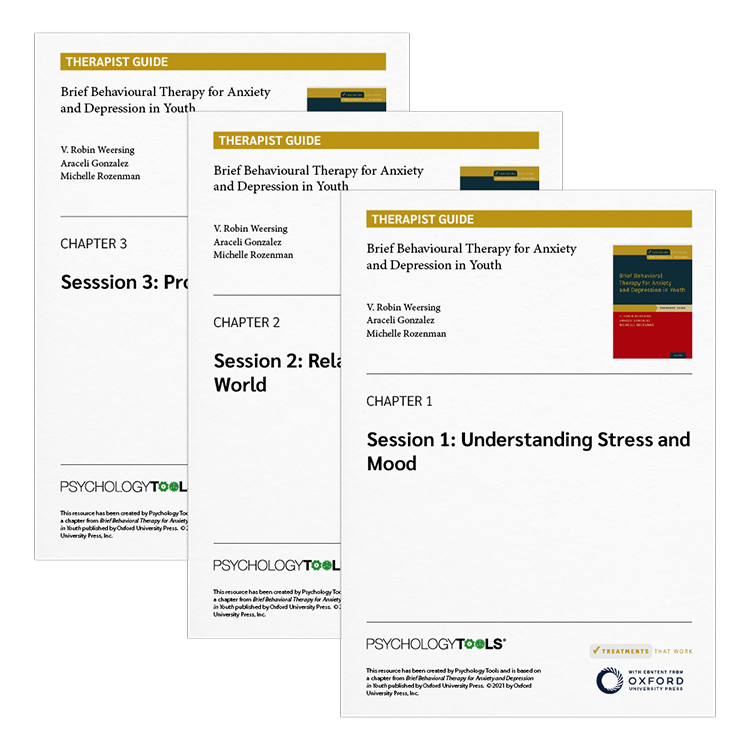
What's inside
- A structured, session-by-session treatment manual.
- Therapist checklists and progress monitoring tools.
- Detailed guidance for implementing cognitive-behavioral interventions for anxiety and depression.
- Case examples and troubleshooting tips for common challenges.
FAQs
How this resource helps improve clinical outcomes
By integrating this resource into therapy, therapists are able to:
- Deliver a structured, comprehensive treatment specifically developed for children and young people.
- Implement effective, evidence-based interventions for anxiety and depression.
- Help clients maintain long-term gains through relapse prevention strategies.
- Tailor treatment to meet children and young peoples' diverse needs.
Clinicians who use this resource also use
References and further reading
- Anderson, P., Toner, P., Bland, M., & McMillan, D. (2016). Effectiveness of transdiagnostic cognitive behaviour therapy for anxiety and depression in adults: A systematic review and meta-analysis. Behavioural and Cognitive Psychotherapy, 44(6), 673–690.
- Bittner, A., Egger, H. L., Erkanli, A., Jane Costello, E., Foley, D. L., & Angold, A. (2007). What do childhood anxiety disorders predict? Journal of Child Psychology and Psychiatry, 48(12), 1174–1183.
- Brent, D. A., Porta, G., Rozenman, M. S., Gonzalez, A., Schwartz, K. T., Lynch, F. L., … Weersing, V. R. (2020). Brief behavioral therapy for pediatric anxiety and depression in primary care: A follow-up. Journal of the American Academy of Child and Adolescent Psychiatry, 59, 856–867.
- Chu, B. C., Crocco, S. T., Esseling, P., Areizaga, M. J., Lindner, A. M., & Skriner, L. C. (2016). Transdiagnostic group behavioral activation and exposure therapy for youth anxiety and depression: Initial randomized controlled trial. Behaviour Research and Therapy, 76, 65–75.
- Ehrenreich-May, J., Kennedy, S. M., Sherman, J. A., Bilek, E. L., Buzzella, B. A., Bennett, S. M., & Barlow, D. H. (2017). Unified protocols for transdiagnostic treatment of emotional disorders in children and adolescents: Therapist guide. New York: Oxford University Press.
- Fergusson, D. M., & Woodward, L. J. (2002). Mental health, educational, and social role outcomes of adolescents with depression. Archives of General Psychiatry, 59(3), 225–231.
- García-Escalera, J., Chorot, P., Valiente, R. M., Reales, J. M., & Sandín, B. (2016). Efficacy of transdiagnostic cognitive-behavioral therapy for anxiety and depression in adults, children and adolescents: A meta-analysis. Revista de Psicopatología y Psicología Clínica, 21(3), 147.
- Garber, J., & Weersing, V. R. (2010). Comorbidity of anxiety and depression in youth: Implications for treatment and prevention. Clinical Psychology: Science and Practice, 17(4), 293–306.
- James, A. C., James, G., Cowdrey, F. A., Soler, A., & Choke, A. (2020). Cognitive behavioural therapy for anxiety disorders in children and adolescents. Cochrane Database of Systematic Reviews, (11), CD004690.
- Lewinsohn, P. M., Sullivan, J. M., & Grosscup, S. J. (1973). Behavioral therapy: Techniques and empirical findings. Annual Review of Psychology, 24, 253–278.
- Lynch, F. L., Dickerson, J. F., Rozenman, M. S., Gonzalez, A., Schwartz, K. T. G., Porta, G., O’Keeffe-Rosetti, M., Brent, D. A., & Weersing, V. R. (in press). Cost-effectiveness of brief behavioral therapy for pediatric anxiety and depression in primary care. JAMA Open Access.
- Merikangas, K. R., He, J. P., Burstein, M., Swanson, S. A., Avenevoli, S., Cui, L., … Swendsen, J. (2010). Lifetime prevalence of mental disorders in US adolescents: Results from the National Comorbidity Survey Replication–Adolescent Supplement (NCS-A). Journal of the American Academy of Child and Adolescent Psychiatry, 49(10), 980–989.
- Newby, J. M., Twomey, C., Li, S. S. Y., & Andrews, G. (2016). Transdiagnostic computerised cognitive behavioural therapy for depression and anxiety: A systematic review and meta-analysis. Journal of Affective Disorders, 199, 30–41.
- Pine, D. S., Cohen, P., Gurley, D., Brook, J., & Ma, Y. (1998). The risk for early-adulthood anxiety and depressive disorders in adolescents with anxiety and depressive disorders. Archives of General Psychiatry, 55(1), 56–64.
- Spielvogle, H., McCarty, C. A., & Richardson, L. P. (2017). Brief therapy for anxiety and depression in the pediatric primary care setting: Implications and next steps. JAMA Pediatrics, 171(10), 1006–1007.
- Walkup, J. T., Mathews, T., & Green, C. M. (2017). Transdiagnostic behavioral therapies in pediatric primary care: Looking ahead. JAMA Psychiatry, 74(6), 557–558.
- Weersing, V. R., Brent, D. A., Rozenman, M. S., Gonzalez, A., Jeffreys, M., Dickerson, J. F., … Iyengar, S. (2017). Brief behavioral therapy for pediatric anxiety and depression in primary care: A randomized clinical trial. JAMA Psychiatry, 74(6), 571–578.
- Weersing, V. R., Rozenman, M. S., Maher-Bridge, M., & Campo, J. V. (2012). Anxiety, depression, and somatic distress: Developing a transdiagnostic internalizing toolbox for pediatric practice. Cognitive and Behavioral Practice, 19(1), 68–82.
- Weersing, V. R., & Weisz, J. R. (2002). Community clinic treatment of depressed youth: Benchmarking usual care against CBT clinical trials. Journal of Consulting and Clinical Psychology, 70(2), 299.
Just enter your name and email address, and we'll send you Brief Behavioral Therapy For Anxiety And Depression In Youth: Therapist Guide (English US) straight to your inbox. You'll also receive occasional product update emails wth evidence-based tools, clinical resources, and the latest psychological research.
Product
Company
Support
- © 2026 Psychology Tools. All rights reserved
- Terms & Conditions
- Privacy Policy
- Cookies Policy
- Disclaimer
Working...
We value your privacy
This site uses strictly necessary cookies to function. We do not use cookies for analytics, marketing, or tracking purposes. By clicking “OK”, you agree to the use of these essential cookies. Read our Cookie Policy
